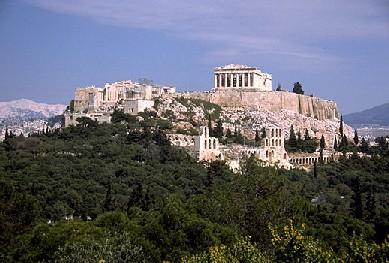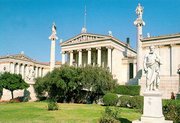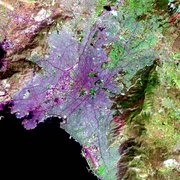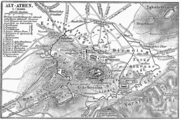Athens
|
|
- For other uses, see Athens (disambiguation).
 The Acropolis in central Athens, one of the most important landmarks in world history. The Parthenon, the main monument on the site, was built in favour of goddess Athena, the patron of the city
The Acropolis in central Athens, one of the most important landmarks in world history. The Parthenon, the main monument on the site, was built in favour of goddess Athena, the patron of the city
Athens (Greek: Αθήνα; see also alternative names) is the capital of Greece, and of the Attica region of Greece. Modern Athens is a large and cosmopolitan city; Ancient Athens was a powerful city-state and renowned center of learning. It is named after its patron goddess, Athena. Athens is located at 37°47'52" North, 23°37'4" East (37.79778, 23.61778). [1] (http://earth-info.nga.mil/gns/html/cntry_files.html)
In Ancient Greek, Athens was called Athinai (Αθήναι, plural for Athena), and in the 19th century this name was formally re-adopted as the city's name. Since the official abandonment of Katharevousa Greek in the 1970s, however, the popular form Athina has become the city's official name.
The city of Athens has a population of 750,001, while the greater metropolitan area is home to some 3.7 million people. Currently the city (metropolitan area) is growing eastwards across Attica.
| Contents |
History
Main article: History of Athens
Athenssunset.jpg
Athens was the leading city in Greece during the greatest period of Greek civilization during the 1st millennium BC. During the "Golden Age" of Greece (roughly 500 BC to 300 BC) it was the Western world's leading cultural and intellectual center, and indeed it is in the ideas and practices of Ancient Athens that what we now call "Western civilization" has its origins. After its days of greatness, Athens continued to be a prosperous city and a centre of learning until the late Roman period.
The schools of philosophy, however, were closed in AD 529 by the Christian Byzantine Empire who disapproved of the schools' pagan thinking. Athens lost a great deal of status and became a provincial town. Between the 13th and 15th centuries the city was fought over by the Byzantines and the French and Italian knights of the Latin Empire. In 1458 the city fell to the Ottoman Empire and the city's population went into decline and conditions worsened as the Ottoman Empire declined as well. Parts of the city (including many of its older buildings) were destroyed in the 17th, 18th and 19th centuries as different factions tried to control the city.
The city was virtually uninhabited by the time it was made the capital of the newly established kingdom of Greece in 1833. During the next few decades the city was rebuilt into a modern city. In 1896 Athens was the host city of the 1896 Summer Olympics.The next large expansion occurred in the 1920s when suburbs were created to house Greek refugees from Asia Minor. During World War II the city was occupied by Germany and fared badly in the war's later years. After the war the city started to grow again.
Location and setting
ZAPPION.jpg

With its suburbs, Athens has a population of about 3.7 million (plus around 500.000 immigrants whose residential status is not stable) representing more than a third of the total population of Greece. Athens has grown very rapidly in the years after the war until ca. 1980 and suffered from overcrowding, traffic congestion and air pollution; it is one of the most polluted cities in Europe. These problems still persist, although the massive investment of recent years in infrastructure has had a significant effect in easing the problem.
Athens sprawls across the central plain of Attica, which is bound by mount Aegaleo on the west, mount Parnitha on the north, mount Penteli to the northeast, mount Hymettus on the east, and the Saronic Gulf on the south-west. Athens has expanded to cover the entire plain, and is thus unlikely to grow significantly in area in the future, because of the natural boundaries. The geomorphology of Athens frequently causes temperature inversion phenomena partly responsible for its air pollution problem (Los Angeles has similar geomorphology and similar problems).
The land is rocky and of marginal fertility. The ancient site of the city is centered on the rocky hill of the Acropolis. In ancient times the port of Piraeus (modern name Pireas) was a separate city, but it has now been absorbed into greater Athens.
The centre of the modern city is at Syntagma Square (Constitution Square), site of the former Royal Palace, the Greek Parliament and other 19th century public buildings. Most of the older and wealthier parts of the city and clustered around this area, which is also where most of the tourist attractions and museums are. The newer parts of the city are mostly constructed from grey concrete and suffer from a lack of parks and amenities.
Athens was host to the 2004 Summer Olympics. Athens was also the host of the 1896 Olympics and of the 1906 Intermediary Olympics.
The old campus of the University of Athens, on Panepistimiou Avenue is one of the finest buildings in Athens, together with the National Library building and the Athens Academy building. These three form the so called Athens Trilogy, built in late 19th century. However most of the university's functions have been moved to a larger modern campus east of the city centre near Zográfou. The second most significant institution of the city is the Athens Polytechnic School (Ethniko Metsovio Politechnio), where more than 20 students were killed in 1973 during demonstrations against the Greek military junta (1967-1974).
Greek entry into the European Union in 1981 brought new investment to the city along with problems of congestion and air pollution. Throughout the 1990s a series of measures were taken successfully to combat pollution. In preparation for the 2004 Olympic games the city spruced up its image with the introduction of state-of-the-art transport means, a new airport, pedestrianised areas, new museums and public squares. The city's increasingly multi-ethnic population enjoy a vibrant night-life and world-class shopping.
Tourist attractions
Zeusnight.jpg
Athens has been a tourist destination since ancient times. Visitors from all over the world have always been very eager to visit the famed monuments of the Acropolis. In recent decades,however, poor infrastructure, pollution and overcrowding of the city damaged its image as a place to visit. Some travel writers said that were it not for the ancient monuments, Athens would not be worth visiting, being dirty, chaotic, crowded and over-priced. Over the past eight years, the infrastructure and social amenities of central Athens have been transformed as a result of the city's successful bid to stage the 2004 Olympic Games. The Greek state aided by the European Union have poured money into infrastructure projects such as the new Eleftherios Venizelos International Airport, the massive expansion of the Metro system, and the new Attiki Odos ring-road. There has also been a great expansion of private investment on hotels and other tourist developments. Most importantly from the point of view of tourism, the area around the Acropolis has been remodelled, and a great pedestrian area from the Temple of Olympian Zeus to Plaka, Monastiraki and the Psirri has been constructed. This gives the visitor space for calm walks among the ancient monuments, ruins and trees, from the Acropolis, to the Agora (the meeting place of the ancient city) and then to the narrow streets of the old city of Athens (the Plaka), away from the noise of the modern city. Close to Syntagma Square (described above) is the Kallimarmaro Stadium, the place where the first modern Olympic Games took place in 1896. Built as a replica of the ancient Athens Stadium, it is interesting, not only for romantic reasons but also because it is probably the only major stadium (holding 60,000 spectators) made entirely of white marble. The classic museums like the National Archaeological Museum (which holds the world's greatest collection of Greek art), the Benaki Museum (including its new Islamic Art branch) [www.benaki.gr], the Byzantine Museum, the Museum of Cycladic Art (strongly recommended for its collection of elegant white metamodern figures, more than 3,000 years old) [www.cycladic-m.gr] have all been renovated in view of the 2004 Olympics. A new Acropolis Museum is being built [2] (http://www.culture.gr/2/21/215/21502/e21509c.html) according to a design by acclaimed architect Bernard Tschumi [3] (http://www.culture.gr/2/21/215/21502/e21509c.html)
As for the night life, central Athens has a great number of multiplex as well as romantic open air garden cinemas, more theatres than any other European city (including ancient marble ones that are home to the Athens Festival from June to July) and many music venues including a state of the art music hall known as "Megaron" [[4] (http://www.megaron.gr)] that attracts world-famous artists all year round. The coastline - now connected to the city centre with a gleaming new tram way - boasts a series of exciting venues next to the beaches where, during the day, Athenians swim and sunbathe. The Psirri district - aka Athens' 'meat packing district'- has acquired many new bars and restaurants and is a center for young Athenians. The Plaka remains the traditional tourist destination, with many tavernas featuring 'traditional' music, but the food, though good, is expensive compared to other parts of the city. The chic Kolonaki area, near Syntagma Square, is full of boutiques catering to well-heeled customers by day and bars and restaurants by night. Some rundown central areas (south of Omonia Square) are mainly peopled by immigrants and are full of colorful if modest ethnic restaurants and shops. Casinos operate on Mount Parnitha (accessible by car or cable car) and the near town of Loutraki (accessible by car or suburban railway). An entirely new attraction is the massively upgraded Olympic Stadium Complex (known by its Greek initials OAKA). The whole area has been remodelled by the Spanish architect Santiago Calatrava with monuments, gardens, futuristic passages and a characteristic new blue glass roof which was added to the main Stadium. A second olympic area, next to the sea at the beach of Kallithea (Faliron), also boasts futuristic stadiums, shops and an elevated esplanade.
For lovers of nature Athens can be very challenging as only few parks exist including the extensive and beautiful national gardens behind the Parliament. To compensate, Athens is close to sand beaches and very clean sea and is surrounded by four very green and easily accessible mountains that are protected national parks (Lycabetus in the centre, Parnitha and Penteli to the North and Ymittos to the South East) some of which feature also unmissable historic sites (Lycabetus,Ymittos). Lycabetus is a large hill in Athens that is said to have been a boulder thrown down by Athena as the legend goes. Lycab(v)etus is pronounced (LEE-KAH-VEE-TOS). Mountain Parnitha 15km from the centre of Athens) has tens of well-marked paths, gorges, springs, torrents and caves and you may meet a deer in the forest. The nearby islands of Aigina, Hydra, Spetses and Poros are also sites of speactacular natural beauty and historical architecture. Work is underway to transform the grounds of the old Athens Airport -named Hellinikon- in the southern suburbs into a massive landscaped park. The Athens municipality maintains a site of tourist interest: http://www.cityofathens.gr/
Transportation
Athens-Transport-Map-All.png
The public transport system in Athens consists of bus, metro, tram and suburban railway [5] (http://www.proastiakos.gr) services.
The Athens Metro is one of the most modern systems in the world. It has three lines which are distinguished by the colours used in maps and signs (green, blue and red). The green line, which is the oldest and for the most part runs on the ground, connects Piraeus to Kifissia. The other two lines were constructed mainly during the 1990s and the first sections were put to service in 2000. They run entirely underground. The blue line goes from Monastiraki to Doukissis Plakentias and the Eleftherios Venizelos International Airport, and the red line from Aghios Antonios to Aghios Dimitrios. Extensions to both lines are under construction, most notably to Marousi and Old Hellinikon Airport East Terminal.
The bus service consists of a network of lines on which normal buses electric buses and natural gas buses run. The bus lines serving Athens and the suburbs are plenty and link the centre of the city with most of the suburbs and neighborhoods.
The tram runs from Syntagma Square to Palaio Faliro and there the line splits in two branches, going to Glyfada and Neo Faliro. Both Syntagma - Palaio Faliro - Neo Faliro and the Glyfada branch opened on 19 July 2004. Further extensions are considered.
There are many taxis in Athens, which can be recognised by the yellow color of the vehicles. They are quite cheap and during rush hours it is considered normal to halt a taxi even when it is in service (although, strictly speaking, this is forbidden); in that case, if the one halting it happens to go to the same direction as the customer and the customer does not mind, he is also allowed in, and each one pays normally as if they were the only customer.
Athens is served by the Eleftherios Venizelos International Airport at Spata, east of the city, about a 45-minute taxi ride from the city centre. There is also an express line connecting the airport to the metro system and 2 express lines connecting the airport to Pireus port and the city centre. Athens is also the hub of the Greek National Railway System, and ferries from Piraeus Port travel to all Greek Islands.
There are two motorways that go to the west towards Patra (GR-8A, E94) and to the north towards Thessaloniki (GR-1, E75), and a ring motorway (Attiki Odos) which goes from Elefsina on the west to the airport after circling the city from the north, and another from Kaisariani to Glyke Nera where it meets the main road for Eleusis and the airport Its total length is now about 70 km in 2004 up from 18 km in March 2001 when it first opened. There are about 21 exits and 4 junctions, up from 8.
See Athens Mass Transit System for more on this topic.
Municipality

The modern city of Athens consists of what were formerly distinct towns and villages which gradually expanded to form a single large city; this expansion occurred in the 20th century. The city is now divided into 54 municipalities, the largest of which is the Municipality of Athens or Dimos Athinaion, with about one million people (the next largest are Piraeus, Peristeri and Kallithea). Athens can therefore refer either to the entire city (also called greater Athens) or to the Municipality of Athens, or even to downtown Athens. Each of the municipalities of Athens has an elected city council and a directly elected mayor. Dora Bakoyanni of the conservative New Democracy party has been Mayor of Athens (that is, of the Municipality of Athens) since October 2002. She is the first woman to be Mayor of Athens.
Olympics 2004
Ceremony4.jpg
Athens was awarded the 2004 Summer Olympics on September 5, 1997 in Lausanne, Switzerland, after surprisingly having lost the bid to organize the 1996 Summer Olympics, the celebration of the 100th anniversary of the modern Olympic Games. It was to be the second time Athens had hosted the Olympic Games.
In 1997, Athens made a bid based largely on an appeal to Olympic history. In the last round of voting, Athens defeated Rome, 66 votes to 41. Before this, Buenos Aires, Stockholm, Cape Town, and San Juan, Puerto Rico, had already been eliminated from consideration after receiving few votes.
3D_View_of_Athens.jpg
After that, the International Olympic Committee expressed its concern over the status of the progress of construction work of the new Olympic venues. A new Organizing Committee was formed under President Gianna Angelopoulos-Daskalaki and preparations began at an accelerated pace. Although the heavy cost was criticized, as is not unusual with Olympic preparations, Athens was transformed into a city that uses state-of-the-art technology in transportation and urban development. Some of the most modern sporting venues in the world were created, almost all of which were fully ready on schedule. The 2004 Games were adjudged a success, as both security and organization were good and few visitors reported problems with transportation or accommodation. The only problem noted was sparse attendance at preliminary events during the first days of competition. Total attendance was more than 3.2 M tickets sold, which was higher that any other Olympics with the exception of Sydney (more than 5M tickets).
Related topics
See also
Cities nicknamed Athens:
- Athens of the East - Madurai, India
- Athens of the South - Nashville, Tennessee
- Athens of the North - Edinburgh, Scotland
- Athens of America - Boston, Massachusetts
- Spree Athens - Berlin, Germany
- Athens of Latin America - Bogotá, Colombia
- Athens of Finland - Jyväskylä, Finland
- Serbian Athens - Novi Sad, Serbia and Montenegro
External links
- City of Athens official website (http://www.cityofathens.gr)
- 2004 Olympics official website (http://www.athens2004.com/)
- Athens travel guide (http://www.greece-athens.com)
- Athens contemporary architecture (http://www.culture2000.tee.gr/)
- The Athenian Constitution, Aristotle (http://www.constitution.org/ari/athen_00.htm)
- Athens photo gallery by Susanne and Andy Carvin (http://www.edwebproject.org/balkans/athens.html)
- Athens pictures (http://www.athensguide.org/pictures-of-athens.html)
- Athens Directory (http://www.around-athens.com)
- Guide to Athens (http://www.cretetravel.com/Athens/Athens_mini_guide/Athens_mini_guide-Museums.htm)
- Map of Central Athens (http://www.cretetravel.com/Athens/Athens_mini_guide/Athens_map.htm)
| North: Galatsi, Filothei | ||
| West: Peristeri, Aigaleo, Tavros, Kallithea | Athens | East: Zografou |
| South: Dafni, Ymittos |
bg:Атина bs:Atina ca:Atenes cs:Athény da:Athen de:Athen et:Ateena el:Αθήνα es:Atenas eo:Ateno eu:Atenas fr:Athènes fy:Atene io:Athina id:Atena it:Atene he:אתונה la:Athenae lt:Atėnai nl:Athene nds:Athen ja:アテネ ko:아테네 nb:Athen nn:Aten pl:Ateny pt:Atenas ro:Atena ru:Афины simple:Athens sk:Atény sl:Atene sr:Град Атина fi:Ateena sv:Aten th:เอเธนส์ uk:Афіни zh:雅典


